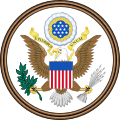Peace and Freedom Party | |
|---|---|
 | |
| Leader | Central Committee |
| Founded | June 23, 1967 |
| Membership (September 2025) | 147,394 registered voters [1] |
| Ideology | Eco-socialism Pacifism Socialist feminism |
| Political position | Left-wing [2] |
| Members in elected offices | 0 |
| Website | |
| peaceandfreedom | |
| Part of a series on |
| Socialism in the United States |
|---|
 |

The Peace and Freedom Party (PFP) is a socialist political party in the United States which operates mostly in California. [2] It was formed in 1966 from anti-Vietnam War and pro-civil rights movements.
Contents
- Organization
- Members
- Preference primaries
- Ideology
- History
- Founding
- Election results
- Presidential elections
- Congressional elections
- Statewide elections
- National conventions
- See also
- Notes
- References
- External links
PFP operates both as an organization unto itself and an umbrella organization in which socialist organizations compete to win PFP's ballot access. [4]
Notable past and present members include Bob Avakian, Emmy Lou Packard, Byron Randall, and (briefly) Murray Rothbard.

